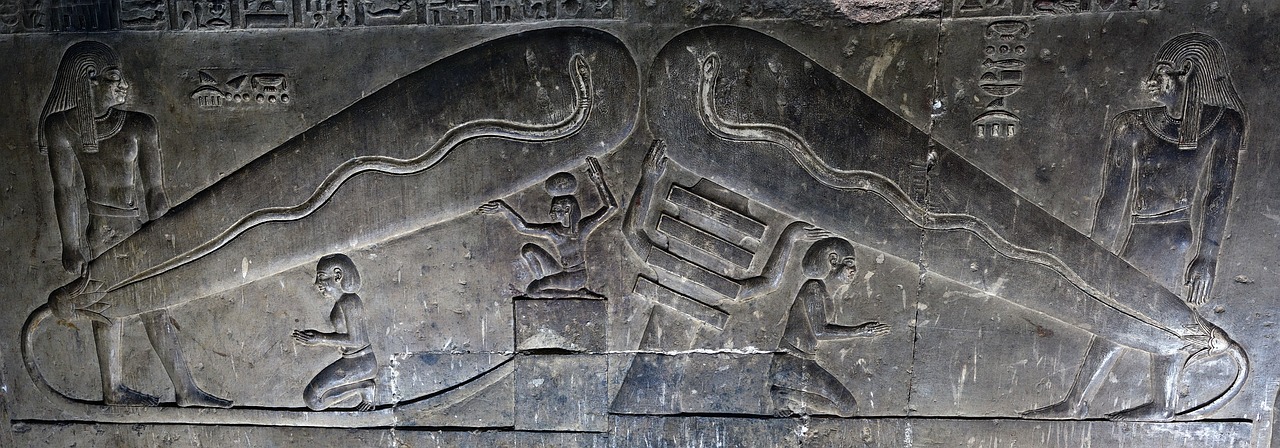A young woman stands in front of her mirror, meticulously applying dark eyeliner. After taking a moment to examine her handiwork, she nods in satisfaction with the results. Before she moves away, her eye catches a gold bracelet, which features an elaborate design of a woman adorned with a cow-horned headdress. Sliding the bracelet up her forearm, she beams at her reflection.
This everyday scene, one familiar to many today, captures the universal ritual of applying makeup and accessorizing. Yet, the tradition of cosmetics and adornment reaches back to ancient civilizations. In cultures like those of ancient Egypt and Nubia, these practices were linked to the worship of deities, particularly the goddess Hathor. For her followers, the celebration of beauty and sensuality was vital.
Understanding the Goddess Hathor
Hathor was a multifaceted goddess in ancient Egyptian mythology. Regarded as the mother of Horus, the sky god, and Ra, the sun god, she encompassed domains such as beauty, sensuality, music, dance, and motherhood. Often depicted with a headdress featuring cow horns and a sun disk, or as a cow or lioness, Hathor was a deity revered from the grand temples of ancient Egypt to the intimate family shrines of Nubia. “The worship of Hathor spread from Egypt to Nubia,” remarks Solange Ashby, an expert in the ancient Egyptian language and religion. “Evidence of her veneration traces back to Egypt’s Old Kingdom, approximately 2300 BCE.”
The ongoing exhibition “Nubia: Jewels of Ancient Sudan” at the Getty Villa displays numerous jewelry pieces, including this bracelet, showcasing Hathor’s recognizable sun disk and horned headdress. She garnered devotion from various social classes in both Egypt and Nubia, often linked with royalty. Egyptian kings are sometimes illustrated as being nurtured by Hathor, viewed as the divine mother of pharaohs in her various forms. The Egyptian queen Tiye, in the 14th century BCE, erected a temple in Nubia dedicated to Hathor, demonstrating her widespread significance. Ashby suggests that the Nubians, initially cattle herders, might have previously worshipped a cattle deity, thus, following Egypt’s conquest, Hathor’s associations with cattle resonated strongly with them.
According to Ashby, Hathor’s worship might appear as a sort of “ancient Egyptian festival” to contemporary audiences. Veneration included “singing, dancing, sexuality, childbirth, and intoxication—whether physical or spiritual.” Singing and dancing often graced her temple ceremonies.
These rituals, vividly illustrated on the walls of sacred sites like the Temple of Philae at the border of Nubia and Egypt, involved “lighting torches, drumming by men, and women with double-headed flutes and rattles,” which are among the most commonly recognized instruments used in celebrating the goddess. “Women would sing and clap while some might dance scantily dressed, performing acrobatic feats adorned with jewelry,” Ashby notes.
Such ceremonies were characterized by playfulness, sensuality, and sometimes overt sexuality. In one narrative, Hathor aids a melancholic Ra by revealing her vulva, a practice adopted by her followers in the act of worship. This explicit sexuality was commonplace within its cultural setting, Ashby highlights. “The ancient Egyptian religion and its writing system contained numerous references to sexuality and illustrated body parts.” Similarly, practices such as anasyrma, where genital exposure occurred during religious rites or humor, were also evident in ancient Greece.
Even though Hathor was widely celebrated, Ashby questions why she remains less recognized compared to other deities, such as Isis, who is the sister-wife of Osiris, the god of the afterlife. One factor is that Isis was more widely known outside of Egypt during subsequent historical periods. “In later times, Isis absorbed the essence of older goddesses,” Ashby explains. “Most information we possess comes from Greek and Roman sources dated between 300 BCE and 300 CE, when they conquered Egypt.” Despite the lack of awareness about Hathor in the ancient Mediterranean world, she continued to be prominently featured in Nubian jewelry during the Greek and Roman eras.
Much of Isis’s iconography adapted from Hathor’s elements, especially in regards to her headdress and the sistrum rattle utilized in temple rituals, hinting that the veneration of Hathor persisted through the worship of Isis. A notable cameo in the Villa’s permanent collection illustrates Isis adorned with Hathor’s sun disk and cow horn headdress.
Today, the devoted worship of Hathor has nearly vanished in predominantly Muslim nations like modern Egypt and Sudan. However, Ashby observes that some contemporary African American communities have revived Hathor’s worship and symbolism, integrating sacred elements such as dance and the use of the rattle, reminiscent of their African spiritual heritage. Given that beauty rituals and the use of cosmetics were integral to goddess worship, it is conceivable that modern practices of adornment trace back to the ancient homage to Hathor.
Watch Solange Ashby’s insightful presentation on Hathor and the significance of ancient Nubian jewelry.



